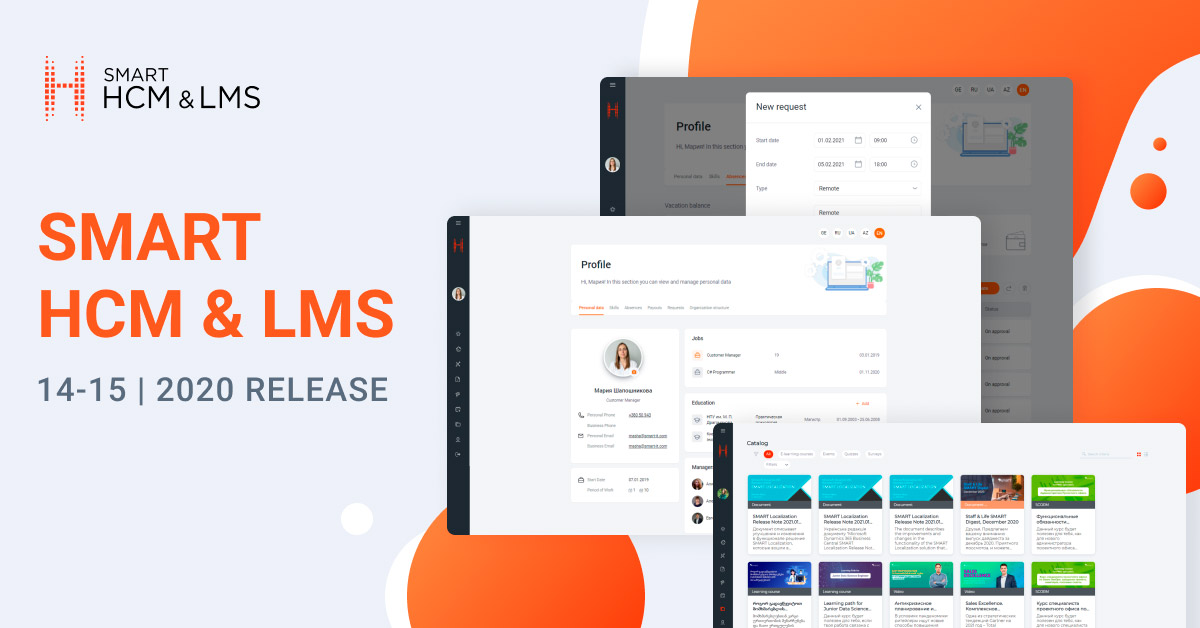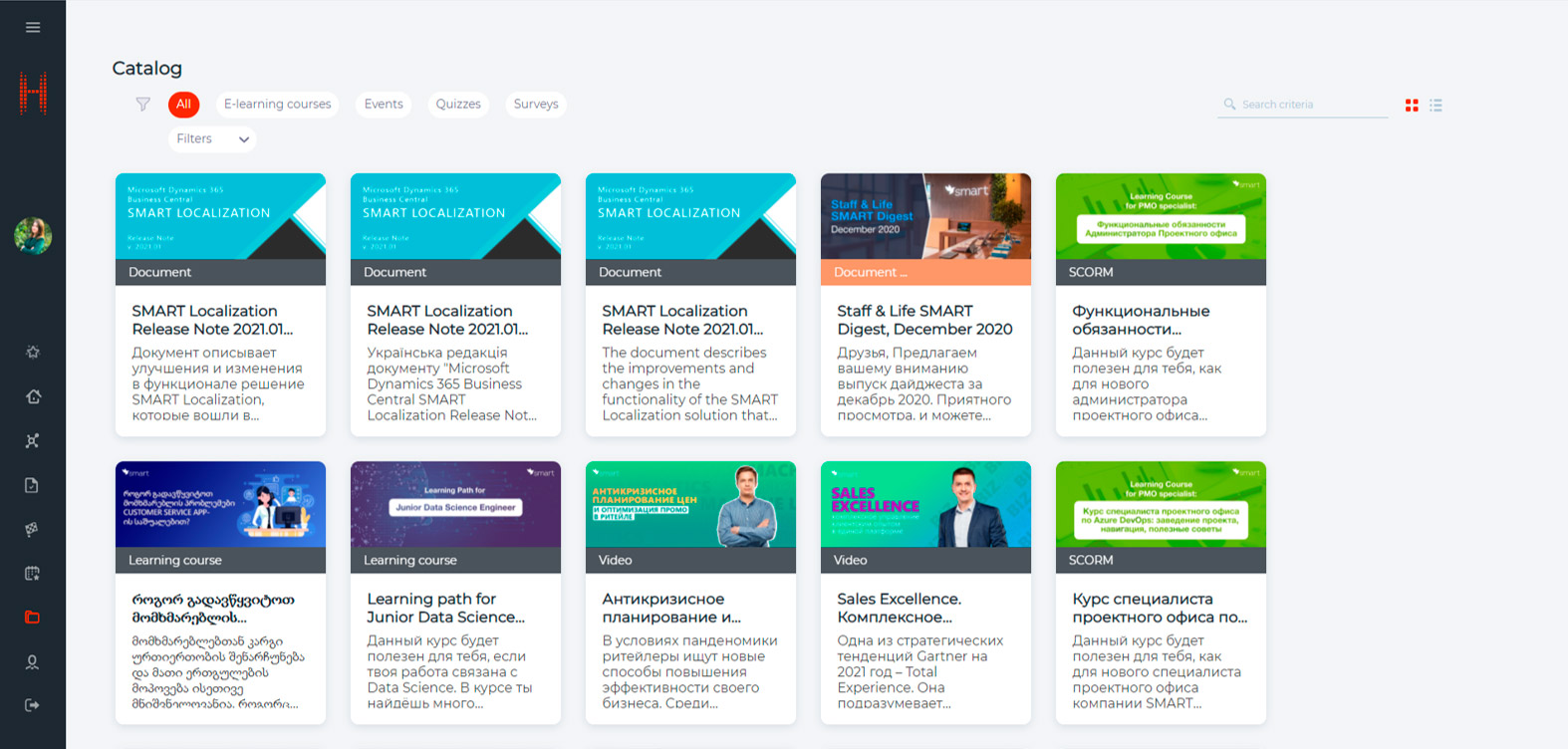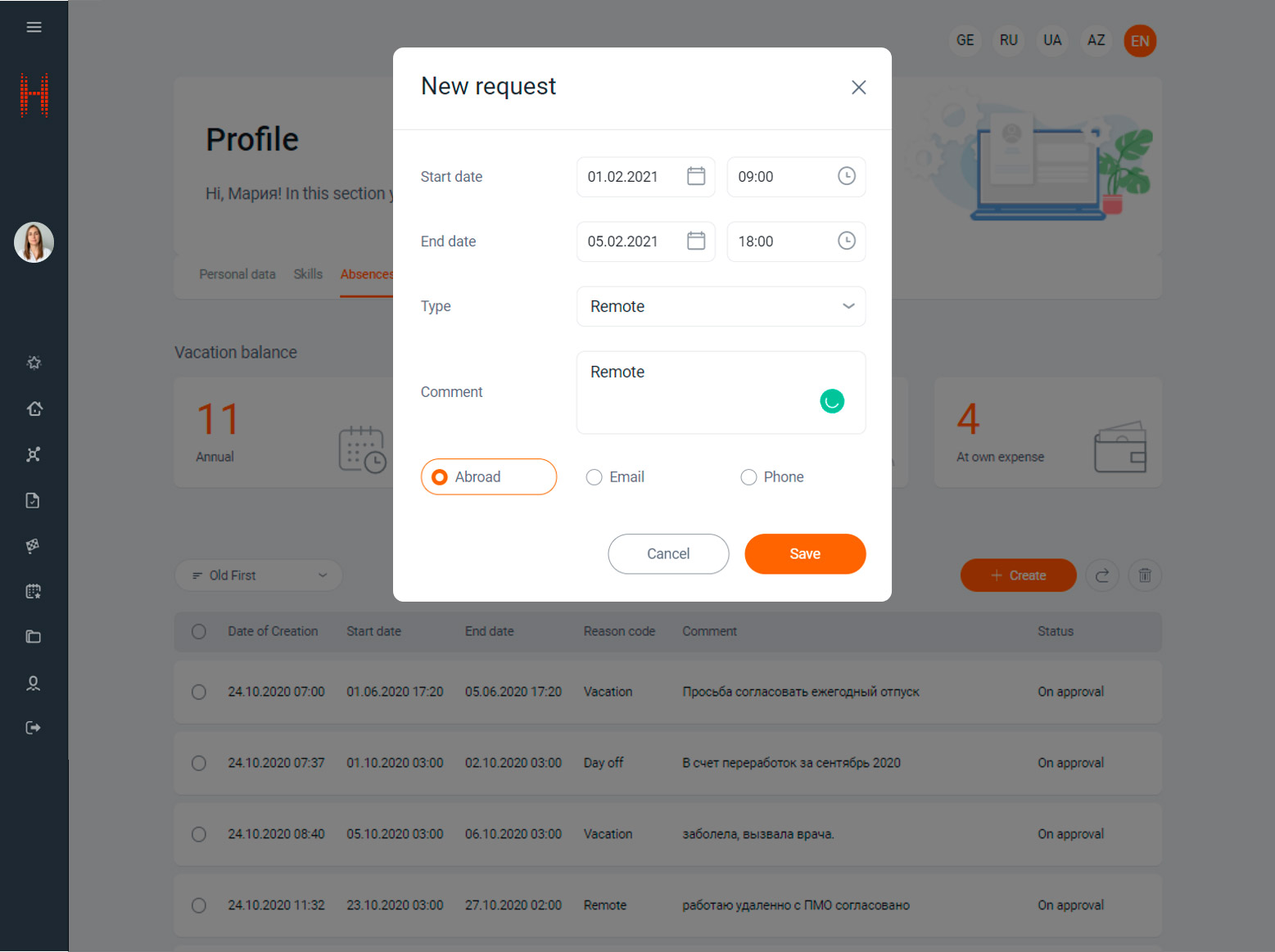
Collecting and analyzing user feedback, in 2020 the SMART business team worked to improve the SMART HCM & LMS system for more convenient and efficient use.
SMART HCM & LMS is designed to automate HR processes and Employee Journey in large and small businesses of various industries. The goal of the system is to improve the efficiency of HR teams and digitalize key HR processes: recruiting, training, developing and retaining talent using digital tools, DATA & AI and analytics.
Our mission is to train and develop employees using technology: to create a platform and provide resources to share expertise, support and accompany them at every stage of the Employee Journey, provide a quality experience from the first contact to offboarding.
SMART HCM & LMS is a real 360-degree employee overview tool that stores all their history in the company, personal data, training and performance information. The task of HR is to assess the employee state at any given time and provide something that will increase their efficiency and engagement.
In the 14th and 15th releases, the development team focused on the following:
- optimization of the recruiter’s time spent on work with vacancies and responses, work with internal customers and external candidates,
- adaptation of design and convenience of the interface to work in the system from various devices, as well as implementing functionality for a user and administrator,
- adaptation of modules and features of the system to implementation via chatbot in order to reduce the time spent on performing routine HR tasks and improve usability,
- updating the Learning Management System for convenient mass assignment and passing of courses, assessment of the material passed by employees,
- improvement of self-service capabilities for employees and much more.
RECRUITING module
R14. Updated integration with DOU.ua job site.
Parsing of CV and cover letter received on DOU.ua when applying for a vacancy has been configured. The updated integration makes it possible to automatically create a candidate and response card, enter the received information into the cards for further analysis and decision making.
R14. API for integration with external company website.
API has been developed that makes it possible to:
- post vacancies on the company’s website in a synchronized way,
- get responses from the career website page,
- save the CVs sent from the website in the system.
R14. Posting vacancies on various job sites from a single interface.
The new “Vacancy Posting” object allows a recruiter to post a job on various platforms and websites from one interface. The vacancy text for each resource can be adapted to its target audience or format. Each response contains information about the channel it was sent from, which makes it possible to determine the most effective websites.
R14. Integration with OLX.ua.
Integration with the Robota| OLX.ua section has been implemented. It allows the recruiter to automatically post vacancies on the resource and get responses.
R14-15. Creating a response to a vacancy from Outlook.
If in response to a vacancy you get an email in Outlook, the system will automatically create a response and a candidate card using the information received and save the CV attached to the email. This will save the recruiter’s time otherwise spent on manually copying and saving the candidate’s data from the email and will help to automatically maintain a single database of responses.
R14. CV parsing.
The system makes it possible to automatically search for data in a CV and fill in the appropriate fields of the candidate card, for example, email. The new feature significantly saves recruiters’ time spent on creating a database of candidates from CV files.
R14. Storing CVs from job sites on SharePoint.
The CVs received from job sites are automatically saved in a document library on SharePoint. SharePoint tools make it possible to view, share CVs, provide other users or other services with access to them. For example, a system administrator can view the received file in a response card in Dynamics.
R14. Chatbot for recruiting.
The system has a configured chatbot recruiter in Telegram as an additional channel for attracting candidates. With the chatbot, a candidate can:
- get brief company info,
- view the entire list of vacancies and find the one they need by keywords,
- get detailed information about a vacancy,
- pass the initial selection, answer questions and indicate contact details,
- send CV as a file or link.
The candidate data are saved in the system when they connect to the chatbot. In the future, the chatbot can be used as a tool for communication or notifying potential candidates of new vacancies.
R14-15. Expanded access to the Recruiting module for a manager.
Using the Recruiting module, each manager can open a vacancy in their department, apply for a candidate search, view its status, response statistics and read the candidate info. Most of the application fields are filled in automatically according to the selected position profile.
When creating a vacancy, the manager can specify additional requirements for candidates.
At the recruitment stage, they take part in the assessment of candidates and provide recruiters with feedback in electronic form. The system stores the entire history of activities and data influencing decision making.
The recruiter sees information about the application and initiator in Dynamics. Working with the application, they can record information about each stage, terms of work and the completion reason.
R14. Automatic completion of the Current stage of work with the candidate.
The script for the automatic completion of the “Current stage of work with the candidate” field has been implemented: the field is automatically filled in when the candidate moves to the next stage. Relevant data are displayed in the selection funnel and simplify reporting generation.
R15. Outlook integration with the calendar in the system.
Due to the integration with Exchange Server, all Outlook calendar activities are synchronized with the calendar in SMART HCM & LMS. This allows the recruiter to see their workload and the schedule of colleagues, schedule calls, meetings with candidates, as well as create a list of tasks for processing responses in the HCM calendar.
R15. Vacancy copy in one click.
By clicking Copy Open Placement in Dynamics, a Recruiter can create a copy of the vacancy in one click and save time on re-entering the same data.
E-learning module: Learning Management System
R14. Updated and adapted design of the LMS portal for mobile devices.
Updating the design of the portal pages has improved its structure and usability. Users can get started with the portal without any introductory instructions. The new player is adapted for all types of materials and maximally expands to full screen, focusing on the content. The portal includes a responsive layout and is accessible from any device.
R14. Unified interface and new portal design in Teams.
The portal pages for the Teams app have been redesigned to support the unified interface.
This allows users to work equally comfortably in the system regardless of the selected interface, Teams or Portal.
R15. Video player for training materials.
The system allows the user to independently set the playback speed of the training video for a comfortable perception of the training material.
R14. Uploading additional materials in learning courses.
The administrator can upload additional material to the learning module. New materials will be available for viewing and downloading on the player page.
R14. New type of learning material Microsoft Stream Video.
The list of content types on the LMS portal has been expanded. Administrators can now link to Microsoft Stream Video as a source of learning material.
R14. Event as a learning course module.
By creating a learning plan, a T&D manager can combine recorded or online training and classroom training courses to implement the concept of “blended learning”.
R14. Passing tests in chatbot.
HR professionals will be able to conduct mass assessment of employee knowledge using chatbots in Teams and Telegram. The tests can use single and multiple choice questions, and the results are saved in the system similarly to testing via the portal. The system also helps to control the re-taking of tests.
R15. Content adaptation for testing.
When creating tests or surveys, the Administrator can specify in which system interfaces they will be displayed. The system will offer fields available for filling in each of them. This will help mitigate the risk of potential errors associated with the limitations of different interfaces. For example, when creating a test for a chatbot, the “Allow Skip Questions” option will be unavailable.
R15. Uninterrupted passing of tests and saving of results.
The system allows an employee to re-start the test and continue testing from the moment it was interrupted. This helps to save results and save time if the Internet connection is suddenly interrupted or the session does not end during the test.
R14. Displaying all assigned learning materials.
The system administrator can track all learning plans, courses, modules and materials assigned to employees in one window. This enables controlling the planned training of employees.
R15. Mass assignment of training.
The system makes it possible to simultaneously assign several plans, courses and modules to selected employees or employees from dynamic lists, and also enables setting up automatic notifications about assigned courses.
R15. The list of automatic notifications.
A new user of the system receives an automatic message about registration on the portal. In turn, the manager receives an automatic notification of the training assigned to their subordinates.
R14. Integration with ZOOM.
Integration with ZOOM Meetings is implemented to organize comprehensive online training, webinars and corporate events. It allows administrators to create a ZOOM Meeting straight from the system and invite participants. After the invitation, the system automatically sends a notification with a connection link and a calendar block, and upon completion it updates the statuses of the participants, which can be used basis for sending a feedback questionnaire and generating a report.
R15. Employee feedback after training.
After training completion, an employee can leave a comment and rate the material covered. The parameters and questions for feedback are determined by the Administrator at the stage of course creation. Analysis of rating and feedback makes it possible to rank courses and quickly improve learning materials with a low score.
R15. Employee certificates.
The system helps to manage internal and external employee certificates. When creating a learning course, the Administrator can select a certificate template that will be automatically assigned to the employee after successful training. On the Portal, an employee can view their Certificate, print it out or share it on social networks. You can also upload an external certificate to the Portal to inform the HR team and keep all achievements in one place.
R15. Indicating the skills the employee will receive after the event.
When creating a training event, the Administrator can indicate a list of skills that will be developed as a result of participation in such event.
WORK WITH EMPLOYEES module
R14. Updated Welcome scenario in Teams chatbot.
The chatbot welcome scenario is adapted to the features of the Teams interface. Visualization and dialogs have been updated for ease of work and better perception by a new employee.
R15. Digital checklist to prepare for employee’s Day 1.
The system allows the Recruiter and all involved persons to prepare in advance for a new colleague’s Day 1. To do this, the Administrator can configure onboarding checklist templates on the Portal. The system will automatically assign tasks from checklists to the employees responsible for preparing and organizing an employee’s Day 1 and notify about the deadlines of these tasks.
R14. Differentiating access to portal sections.
On the portal, each employee sees their personal information and sections to which they have access according to the assigned roles and duties. For example, employee personal data can only be accessed by the HR team, while only the team of finance specialists and responsible managers will have access to financial reports. In addition, it helps protect sections during implementation from “unplanned testing”.
R15. Profile page redesign.
To make the work with the portal even more convenient, the structure and design of the “Profile” page have been changed. Information in the profile of each employee is now structured by sections, and access to each of them is limited according to the user roles.
R15. Goal setting for employees.
The system makes it possible to implement and automate the process of setting, approving and cascading goals. Goals can be set an assessed at the level of the whole company, individual departments and employees, and the flexible system capabilities enable customizing the process to the company needs.
R15. Digitalized employee dismissal process.
The system enables automating the offboarding process from the moment the HR manager records the information about dismissal in the employee’s card. The system has a list of “exit interview” questionnaires, from which you can choose a template to be automatically sent to an employee. The results of the questionnaire are saved in the system and are available for analysis. The system will automatically notify the participants in the process about the need to complete the assigned tasks, and the system deactivates all employee contracts on the day of dismissal.
R14. Vacation request via chatbot.
Due to the implemented OutOfOffice scenario with the “Vacation” reason, employees can quickly and conveniently submit a Vacation request via a chatbot. The request is automatically duplicated in the system, and the HR manager receives a corresponding notification.
R15. Absence requests on the Portal.
Implementation of the Absence functionality has started. It will allow employees to submit Day-off requests straight from the portal.
R14. Storing employee photos in the cloud.
Automatic uploading and storage of employee photos in a single cloud-based Azure Blob Storage makes it possible to use the same employee photo in different services of the system. For example, in a Portal profile or in the “Employee Search” scenario in the chatbot. When changing a photo in one of the services, it automatically changes in the other ones, too.
R14. Skills and Praise in Teams chatbot.
The “My Skills” and “Praise” sections of the portal are available to employees in the Teams chatbot, similar to Telegram, where employees can use a convenient and familiar interface. When using data, the system saves information about the interface from which the object was created, which allows you to analyze activity and determine the most popular channels.
R15. “General HR metrics” set of reports.
The system lets you automatically generate a number of reports on the main HR metrics. For convenience and efficiency, the system already has a set of prepared and implemented Power BI reports.
EMPLOYEE ASSESSMENT module
R14. Mass surveys in Survey.
Using the mechanism of assignment and allocation, the Administrator can organize and conduct mass surveys, assign questionnaires to employees, managers or mentors depending on the tasks.
R14. Choosing the type of manager in the assessment procedure.
During the organization of personnel assessment (skills, competencies, KPIs, surveys), the Administrator can indicate the type of manager: Administrative, Functional, Mentor. This enables expanding the range of assessed persons and save time on assigning assessment forms to them.
R15. New features for organizing surveys.
When creating a survey or questionnaire, the Administrator can specify the time of its completion and the number of questions. The timer and the number of questions will be displayed on the user’s screen during the test so that they can estimate their time realistically.
R15. Sequence of questions and answers in tests and surveys.
When creating test questions, the Administrator can set the sequence of their display on the portal. This saves the logic of the survey and makes it easier for the user to pass it.
R15. Calculating test results by points.
While creating test questions, the Administrator can set the complexity of the question and indicate the score for the correct or incorrect answer. The system makes it possible to accept both full and partial answers from participants. Using the test interface, you can organize not only employee knowledge level assessment, but also conduct psychological testing.
GAMIFICATION module
R15. New design of the “My Badges” page.
A new design for the “My Badges” page has been developed to improve user experience and simplify navigation.
EVENT MANAGEMENT module
R14. Confirmation of registration for a corporate event and limiting the maximum number of participants.
In the Event Management module, the system administrator gets the opportunity to manage registrations for events and control the maximum number of participants. When creating a new event, the administrator can indicate the need to confirm registration and verify the applications on their own. And in case of exceeding the permissible number of registrations specified in the event card, applications for participation will be included in the waiting list.
OTHER
R14. Other system improvements that increase its performance and usability:
- The “Mandatory” sign for test questions has been hidden.
- The “Correct/Incorrect” sign for answer options in a Survey has been hidden.
- Automatic completion of the Start Date = 9:00 and End Date = 18:00 of the event has been implemented.
- Portal homepage loading has been optimized.
- Data synchronization between CRM and the portal has been optimized.
Follow the link and test SMART HCM & LMS right now!







